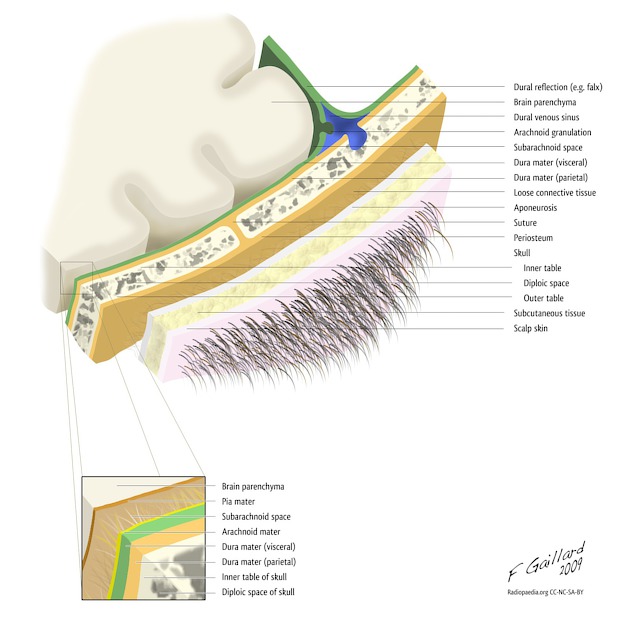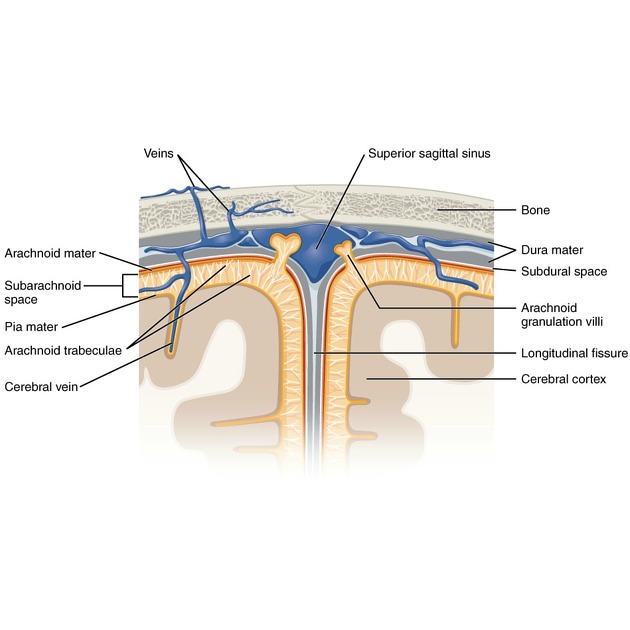Pia mater
Citation, DOI, disclosures and article data
At the time the article was created Julian Maingard had no recorded disclosures.
View Julian Maingard's current disclosuresAt the time the article was last revised Tariq Walizai had no financial relationships to ineligible companies to disclose.
View Tariq Walizai's current disclosuresThe pia mater is the innermost layer of the meninges and together with the arachnoid mater is referred to as the leptomeninges. It is closely related to the surface of the brain and unlike the arachnoid mater extends into the sulci 1.
On this page:
Gross anatomy
The pia mater is separated from the arachnoid mater by the CSF-filled subarachnoid space and only connected to this outer membrane by the arachnoid trabeculae 2. It is impermeable to CSF 1.
It is a highly vascular layer containing blood vessels that supply the underlying surface of the brain particularly over the cerebrum 3. At the point where blood vessels enter the underlying neural tissue, extensions of the pia mater are carried with them creating a perivascular space 1. Because the brain does not have a true lymphatic system this perivascular space is important in allowing the movement of substances back into the CSF.
At certain points in the third, fourth and lateral ventricles the pia mater forms a double layer and is covered by ependymal cells to create the tela choroidea. In the third ventricle a double-layered tela choroidea forms the velum interpositum 4.
At certain points the tela choroidea bulges into the ventricle and is closely associated with numerous villous processes and an underlying vascular bundle. This is the choroid plexus and involved in the production of CSF 1.
History and etymology
"Pia mater" derives from medieval Latin for "soft mother". This term was created in Stephen of Antioch's translation of Hali Abbas in the 12th century 5. Arabic medicine at that time conjectured that the meninges gave rise to all the membranes of the body and expressed relationships between different tissue types in terms of familial relationships (mother, son, daughter, etc.).
Related pathology
Quiz questions
References
- 1. Singh. Textbook of Anatomy with Colour Atlas. Jaypee Brothers Medical Publishers (P) Ltd. ISBN:8180618331.
- 2. Kulkarni NVM. Clinical Anatomy:. Jaypee Brothers Medical Pub. ISBN:9350254972.
- 3. Yasargil MG. Microneurosurgery, Volume IIIA: AVM of the Brain, History, Embryology, Pathological Considerations, Hemodynamics, Diagnostic Studies, Microsurgical Anatomy (Microneurosurgery, No 3a)
- 4. Kier LE. The evolutionary and embryologic basis for the development and anatomy of the cavum veli interpositi. AJNR Am J Neuroradiol. 2000;21 (3): 612-4. Pubmed citation
- 5. Skinner HA. Origin of Medical Terms. Hafner Publishing Co Ltd. ISBN:0028523903. Read it at Google Books - Find it at Amazon
Incoming Links
- Subpial haemorrhage
- Tumefactive perivascular spaces
- Septum pellucidum
- Subarachnoid space
- Tuberculous meningitis
- Leptomeninges
- Blood supply of the meninges
- Tela choroidea
- Subarachnoid cisterns
- Velum interpositum
- Inferior medullary velum
- Dura mater
- Schizencephaly
- Cranial meninges
- Leptomeningitis
- Arachnoid membranes
- Meninx primitiva
- Spinal pia mater
- Arachnoid mater
- Superior medullary velum
Related articles: Anatomy: Brain
-
brain
- grey matter
- white matter
-
cerebrum
-
cerebral hemisphere (telencephalon)
- cerebral lobes and gyri
- frontal lobe
- parietal lobe
-
occipital lobe
- occipital pole
- lingual gyrus
- fusiform gyrus (Brodmann area 37)
- calcarine (visual) cortex
- cuneus
- temporal lobe
- basal forebrain
- limbic system
- insula
-
cerebral sulci and fissures (A-Z)
- calcarine fissure
- callosal sulcus
- central (Rolandic) sulcus
- cingulate sulcus
- collateral sulcus
- inferior frontal sulcus
- inferior occipital sulcus
- inferior temporal sulcus
- interhemispheric fissure
- intraparietal sulcus
- lateral (Sylvian) sulcus
- lateral occipital sulcus
- marginal sulcus
- occipitotemporal sulcus
- olfactory sulcus
- paracentral sulcus
- paraolfactory sulcus
- parieto-occipital fissure
- posterior parolfactory sulcus
- precentral sulcus
- preoccipital notch
- postcentral sulcus
- rhinal sulcus
- rostral sulcus
- subparietal sulcus
- superior frontal sulcus
- superior occipital sulcus
- superior temporal sulcus
- cortical histology
- cerebral lobes and gyri
- white matter tracts
- deep grey matter
-
pituitary gland
- posterior pituitary and stalk (part of diencephalon)
- anterior pituitary
- inferior hypophyseal arterial circle
- diencephalon
-
cerebral hemisphere (telencephalon)
-
brainstem
- midbrain (mesencephalon)
- pons (part of metencephalon)
- medulla oblongata (myelencephalon)
- white matter
-
grey matter
- non-cranial nerve
-
cranial nerve nuclei
- oculomotor nucleus
- Edinger-Westphal nucleus
- trochlear nucleus
- motor nucleus of CN V
- mesencephalic nucleus of CN V
- main sensory nucleus of CN V
- spinal nucleus of CN V
- abducent nucleus
- facial nucleus
- superior salivatory nucleus
- cochlear nuclei
- vestibular nuclei
- inferior salivatory nucleus
- solitary tract nucleus
- ambiguus nucleus
- dorsal vagal motor nucleus
- hypoglossal nucleus
-
cerebellum (part of metencephalon)
- vermis
- cerebellar hemisphere
- cerebellar peduncles
- cranial meninges (meninx primitiva)
- CSF spaces
-
cranial nerves (mnemonic)
- olfactory nerve (CN I)
- optic nerve (CN II)
- oculomotor nerve (CN III)
- trochlear nerve (CN IV)
- trigeminal nerve (CN V) (mnemonic)
- abducens nerve (CN VI)
- facial nerve (CN VII) (segments mnemonic | branches mnemonic)
-
vestibulocochlear nerve (CN VIII)
- vestibular ganglion (Scarpa's ganglion)
- glossopharyngeal nerve (CN IX)
- vagus nerve (CN X)
- spinal accessory nerve (CN XI)
- hypoglossal nerve (CN XII)
- functional neuroanatomy
- CNS development
- cerebral vascular supply
- arteries
- vascular territories
-
circle of Willis
- internal carotid artery (ICA) (segments)
- vertebral artery
-
normal variants
- intracranial arterial fenestration
- internal carotid artery (ICA)
- anterior cerebral artery (ACA)
- middle cerebral artery (MCA)
- posterior cerebral artery (PCA)
- basilar artery
- persistent carotid-vertebrobasilar artery anastomoses (mnemonic)
- vertebral artery
- ophthalmic artery
-
cerebral venous system
-
dural venous sinuses
- basilar venous plexus
- cavernous sinus (mnemonic)
- clival diploic veins
- inferior petro-occipital vein
- inferior petrosal sinus
- inferior sagittal sinus
- intercavernous sinus
- internal carotid artery venous plexus of Rektorzik
- jugular bulb
- marginal sinus
- occipital sinus
- sigmoid sinus
- sphenoparietal sinus
- straight sinus
- superior petrosal sinus
- superior sagittal sinus
- torcula herophili
- transverse sinus
-
cerebral veins
-
superficial veins of the brain
- superior cerebral veins (superficial cerebral veins)
- inferior cerebral veins
- superficial middle cerebral vein
- superior anastomotic vein (of Trolard)
- inferior anastomotic vein (of Labbe)
-
superficial veins of the brain
-
deep veins of the brain
- great cerebral vein (of Galen)
- venous circle of Trolard
- normal variants
-
dural venous sinuses
- arteries
- glymphatic pathway
Related articles: Anatomy: Spine
-
osteology
- vertebrae
- spinal canal
- cervical spine
- thoracic spine
- lumbar spine
- sacrum
- coccyx
-
anatomical variants
- vertebral body
- neural arch
- transitional vertebrae
- ossicles
- ossification centers
- intervertebral disc
- articulations
- ligaments
- musculature of the vertebral column
- muscles of the neck
- muscles of the back
-
suboccipital muscle group
- rectus capitis posterior major muscle
- rectus capitis posterior minor muscle
- obliquus capitis superior muscle
- obliquus capitis inferior muscle
- splenius capitis muscle
- splenius cervicis muscle
- erector spinae group
- transversospinalis group
- quadratus lumborum muscle
-
suboccipital muscle group
- spinal meninges and spaces
-
spinal cord
- gross anatomy
-
white matter tracts (white matter)
- corticospinal tract
- anterolateral columns
- lateral columns
-
dorsal columns
- fasiculus gracilis (column of Goll)
- fasiculus cuneatus (column of Burdach)
- grey matter
- nerve root
- central canal
- functional anatomy
- spinal cord blood supply
- sympathetic chain







 Unable to process the form. Check for errors and try again.
Unable to process the form. Check for errors and try again.